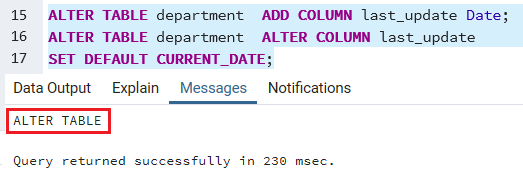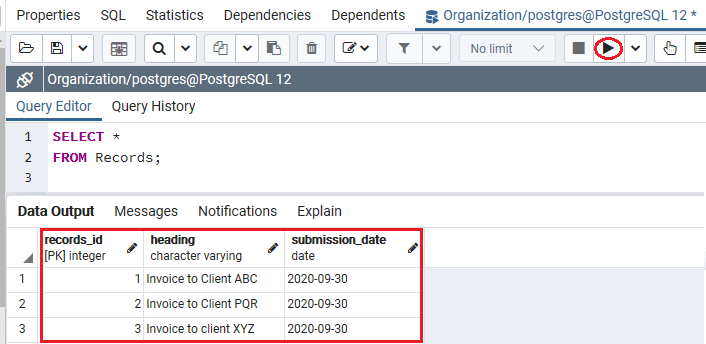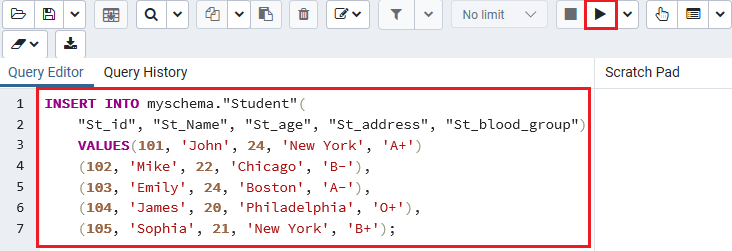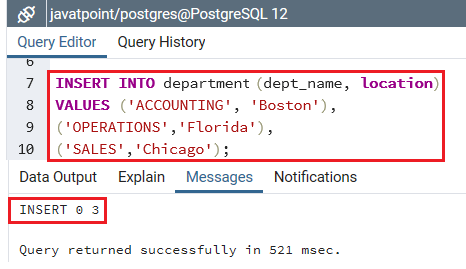

The first record would have a contact_id of 250, a last_name of 'Anderson', first_name of 'Jane', and whatever the default value is for the country field. This PostgreSQL INSERT statement would result in two records being inserted into the contacts table.

You could use the syntax above to insert more than one record at a time. This new record would have a contact_id of 250, a last_name of 'Anderson', first_name of 'Jane', and whatever the default value is for the country field. This PostgreSQL INSERT statement would result in one record being inserted into the contacts table. (contact_id, last_name, first_name, country) The simplest way to create a PostgreSQL INSERT query to list the values using the VALUES keyword. They are the conditions that must be met for the records to be inserted.

It is the source table when inserting data from another table. All columns will be populated with their default values. DEFAULT VALUES Used in the second syntax. If DEFAULT is specified, the corresponding column will be populated with its default value. If expression1 is specified, then column1 would be assigned the value of expression1, column2 would be assigned the value of expression2, and so on. These are the values to assign to the columns in the table. expression1 | DEFAULT, expression2 | DEFAULT Used in the first syntax. column1, column2 The columns in the table to insert values. Parameters or Arguments table The table to insert the records into. The syntax for the INSERT statement when inserting multiple records using a sub-select in PostgreSQL is: INSERT INTO table The syntax for the INSERT statement when inserting a single record using the DEFAULT VALUES keyword in PostgreSQL is: INSERT INTO table (expression1 | DEFAULT, expression2 | DEFAULT. Idpostgres Passwordpostgres hostlocalhost databasepostgres ). The syntax is as follows: INSERT INTO table1 (column11, column12.
#Postgresql insert how to#
NOTE: You’ll notice that some datatypes include (NUM)- this represents an integer for the precision character length that is passed while creating the table.The syntax for the PostgreSQL INSERT statement when inserting record(s) using the VALUES keyword is: INSERT INTO table This tutorial describes how to use PgSqlCommand component to insert data into tables. PostgreSQL INSERT INTO table from SELECT query You can populate data into a table in PostgreSQL by using a SELECT query to select the data from some table to be returned as the VALUES in the INSERT INTO statement. In addition to these commonly-used datatypes, there are other types such as UUID for unique identifiers of a specified length, and JSON for data that adheres to the JavaScript object-notation syntax. These are just a few of the numeric datatypes used for floats and integers. INT, INTEGER, BIGINT, SERIAL, DECIMAL(NUM), FLOAT(NUM), etc. VARCHAR(NUM), CHAR(NUM), and TEXT - These datatypes are used for strings and text, which encompasses a wide range of ASCII characters. Refer to the SELECT statement for a description of the syntax. We’ll begin our discussion with a brief overview of the various PostgreSQL datatypes:īOOLEAN - This datatype must have a true or false value, but it also accepts t or f (or yes and no) when data is inserted. A query ( SELECT statement) that supplies the rows to be inserted. Once connected to the database, you’ll use the INSERT INTO command to insert data row(s) into a table. This command allows you to access a PostgreSQL database in order to insert data. Another method is, we can use the UPSERT method. We can use the subquery to check if the row is present in the table.
#Postgresql insert update#
We can insert a single row or multiple row values at a time into the particular table. PostgreSQL PostgreSQL Upsert Created: September-07, 2022 Use Subquery to Insert or Update Row if It Exists Use UPSERT to Insert or Update Row if It Exists There are two ways to perform an insert or update if they exist. You’ll need to have PostgreSQL installed on your machine, and you’ll need to be able to use the psql command in a terminal or command prompt window. In PostgreSQL, the INSERT command is used to insert new rows into a table. There are only a couple of basic prerequisites that need to be in place in order to follow along with this tutorial. In this article, we’ll show you how to connect to PostgreSQL using the psql command and insert data into a PostgreSQL table with the INSERT statement. Fortunately, this task is easy to accomplish using the INSERT command.

If you’re getting started with PostgreSQL, one of the first things you’ll want to do is insert some data into tables.


 0 kommentar(er)
0 kommentar(er)
